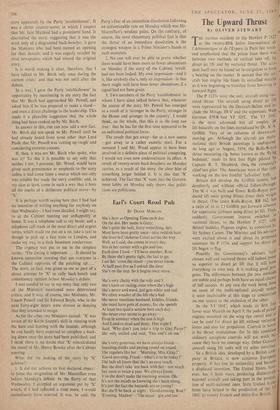The Upward Thrust
By OLIVER STEWART THE curious accident to the Hawker P 1127 at the twenty-fifth Salon International de l'Adronautique et de l'Espace in Paris last week- end emphasised that the prime issue there was between two methods of vertical take off, by direct jet lift and by vectored thrust. The acci- dent itself may be found on investigation to have a bearing on the matter. It seemed that the air- craft lost engine life from its swivelled nozzles as it was beginning to translate from hovering to forward flight.
The P 1127s were the only aircraft using vec- tored thrust. The aircraft using direct jet lift were represented by the Dassault-Balzac and in- clude the Mirage III-V and the supersonic West German EWR-Sud VJ 101C. The VI 1010 is the most advanced but all employ let lift basically on the lines introduced by Dr. A. A. Griffith. They sit on columns of downy' ard- moving gas. Although the aircraft- are multi' national their British parentage is undisputed. As long ago as August, 1954, the Rolls-Rqce thrust measuring rig, better known as the 'flying bedstead,' made its first free flight piloted by Captain R. T. Shepherd, then, the company's chief test pilot. The Americans were at that time working on the less fruitful `tail-sitter' type. Britain did develop the Griffith system, but desultorily and without official follow-through. The SC-1 was built and flown. Rolls-Royce pro- duced lift units giving fifteen times their weight in thrust. (The latest Rolls-Royce, RB 162, has a ratio of 16 to 13 Griffith put forward schemes for supersonic airliners using direct jet lift. Then, suddenly, Government interest switched .t° vectored thrust, to the Hawker P 1127, with Bristol Siddelcy Pegasus engine, as conceived by Sir Sydney Carnm. The Minister and his advisers were excited about it and about its proposed successor the P 1154, and support for direct let lift began to flag. Possibly the Government's advisers ha'e chosen well and vectored thrust will indeed pro° so superior to direct jet lift that it will have everything its own way. It is making good pro- gress. The differences between the two methods are subtle and perhaps both have an equal chance of full success. At any rate the work being done on some of the multi-national aircraft Makes it seem inadvisable at this stage to concentrate on one system to the exclusion of the other. In the VJ 101C, which made its first free hover near Munich on April 9, the pods of paired engines mounted on the wing tips swivel and s° can be used for direct jet lift without vectoring losses and also for propulsion. Control in ho''er is by thrust modulation—for in this condition ordinary aeroplane controls will pot work be. cause they have no steerage way. Other German aircraft using lift units will try other novelties. So a British idea, developed by a British con' pany in Britain, is now common European property. It has lost its nationality and become a displaced invention. The United States, ho"' ever, has it both ways, producing distinctively national aircraft and taking part in the prod Lion of multi-national ones. Sixty United State5, firms have helped in the production of the \,/ 101C to twenty French and thirty-five British.


































 Previous page
Previous page